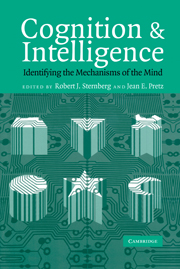Book contents
- Frontmatter
- Contents
- Preface
- 1 Information Processing and Intelligence: Where We Are and Where We Are Going
- 2 Mental Chronometry and the Unification of Differential Psychology
- 3 Reductionism versus Charting: Ways of Examining the Role of Lower-Order Cognitive Processes in Intelligence
- 4 Basic Information Processing and the Psychophysiology of Intelligence
- 5 The Neural Bases of Intelligence: A Perspective Based on Functional Neuroimaging
- 6 The Role of Working Memory in Higher-Level Cognition: Domain-Specific versus Domain-General Perspectives
- 7 Higher-Order Cognition and Intelligence
- 8 Ability Determinants of Individual Differences in Skilled Performance
- 9 Complex Problem Solving and Intelligence: Empirical Relation and Causal Direction
- 10 Intelligence as Smart Heuristics
- 11 The Role of Transferable Knowledge in Intelligence
- 12 Reasoning Abilities
- 13 Measuring Human Intelligence with Artificial Intelligence: Adaptive Item Generation
- 14 Marrying Intelligence and Cognition: A Developmental View
- 15 From Description to Explanation in Cognitive Aging
- 16 Unifying the Field: Cognition and Intelligence
- Author Index
- Subject Index
- References
3 - Reductionism versus Charting: Ways of Examining the Role of Lower-Order Cognitive Processes in Intelligence
Published online by Cambridge University Press: 23 November 2009
- Frontmatter
- Contents
- Preface
- 1 Information Processing and Intelligence: Where We Are and Where We Are Going
- 2 Mental Chronometry and the Unification of Differential Psychology
- 3 Reductionism versus Charting: Ways of Examining the Role of Lower-Order Cognitive Processes in Intelligence
- 4 Basic Information Processing and the Psychophysiology of Intelligence
- 5 The Neural Bases of Intelligence: A Perspective Based on Functional Neuroimaging
- 6 The Role of Working Memory in Higher-Level Cognition: Domain-Specific versus Domain-General Perspectives
- 7 Higher-Order Cognition and Intelligence
- 8 Ability Determinants of Individual Differences in Skilled Performance
- 9 Complex Problem Solving and Intelligence: Empirical Relation and Causal Direction
- 10 Intelligence as Smart Heuristics
- 11 The Role of Transferable Knowledge in Intelligence
- 12 Reasoning Abilities
- 13 Measuring Human Intelligence with Artificial Intelligence: Adaptive Item Generation
- 14 Marrying Intelligence and Cognition: A Developmental View
- 15 From Description to Explanation in Cognitive Aging
- 16 Unifying the Field: Cognition and Intelligence
- Author Index
- Subject Index
- References
Summary
Following on Locke's theory that the senses are the building blocks of thinking and knowledge, Galton (1883) proposed that fine differences in sensory discrimination should be related to individual differences in cognitive ability. Although the evidence accumulated by the beginning of the twentieth century strongly rejected this proposal, near the end of that same century, there was a re-emergence of related views. These views have always been motivated by a desire to uncover the biological roots of intelligence.
The groundwork for a renewed interest in the relationship between lower-order processes and intelligence was set in the 1970s with developments that eventually crystallized into different programmatic orientations and aims. One of these was frankly reductionist and very much in a Galtonian tradition. The other approach — charting — was motivated by a realization that, for historical and technical reasons, the domain of cognition was far from being covered in all its breadth in psychometric studies of intelligence; the task of mapping it out is far from being finished. In the late 1980s research on cognitive aging, which is somewhat removed from the traditional area of intelligence, also moved in the direction of linking lower-order processes and intelligence. This work, however, combined both reductionist and charting features. My aim in this chapter is to review recent developments within these three orientations and consider implications for psychometric theories of intelligence.
Contemporary work in all three orientations has been influenced by developments that saw changes in the interpretation of “sensory.”
- Type
- Chapter
- Information
- Cognition and IntelligenceIdentifying the Mechanisms of the Mind, pp. 51 - 67Publisher: Cambridge University PressPrint publication year: 2004

